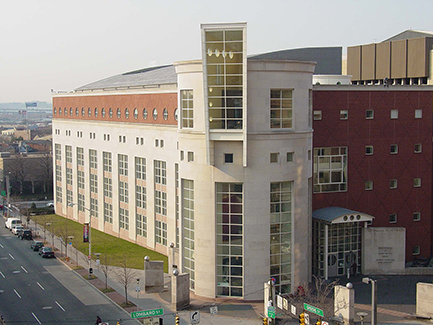Historical Insights: The University of Maryland Faculty of Divinity
October 02, 2024
Throughout its long history, the University of Maryland, Baltimore (UMB) has seen many other Baltimore colleges and universities open and close. Some of these schools simply shuttered their doors, while others merged with UMB. Historical Collections still houses materials from some of these schools. This year, Historical Collections aims to tell the stories of these defunct schools in blog posts.
In a previous post, the history of UMB’s School of Arts and Sciences or School of Letters was covered. The same 1812 charter that started the School of Arts and Sciences:
And be it enacted, That the professors now appointed and authorized in the College of Medicine of Maryland, and their successors, shall constitute the Faculty of Physic; that the professor of theology, together with six ordained ministers of any religious society or denomination, and their successors, shall form and constitute the Faculty of Divinity.
Thus, the School of Divinity of the University of Maryland was founded. At the first faculty meetings of the new University of Maryland in 1812, the following men were named to the School of Divinity:
Rev. Frederick Beasley (Professor of Theology)
Rev. James Inglis, DD, Presbyterian
Rev. John Daniel Kurtz, Lutheran
Rev. George Roberts, Methodist
Right Rev. James Kemp, DD, Protestant Episcopal Bishop of Maryland
Rev. John Glendy, Presbyterian
Rev. George Dashiell, Protestant Episcopal
As required by the charter, each of the faculty members represented a different sect of Christianity; the goal was to encourage religious tolerance. It’s unclear, though, if the Maryland Legislature really envisioned tolerance for all religions or just tolerance among the Christian sects since no other religion was represented on the faculty.
By 1815, Reverend Dashiell resigned from the faculty and was replaced by Rev. William E. Wyatt, AM. In 1819, the Faculty of Divinity was called upon by the University to develop a course of lectures called “On the Evidences of Christianity.” Reverend Wyatt delivered this course on Sundays so as not to interfere with the medical school classes and was open to all students at the University. The Bylaws, completed in 1821 under then-Dean Reverend Wyatt, of the Faculty of Divinity decreed:
It shall be the business of the Faculty to promote religious principles in the University; & for this purpose, their Professor shall deliver during every term, when the Medical students are attending the University Lectures on such subjects as may appear most likely to promote correct principles & pious habits among the young Gentlemen of the Institution. And whenever a theological class can be obtained, the Professor shall deliver lectures on the same terms with the Medical Lectures. These Lectures shall be on general topics. Such as the Evidence of Christianity, the divine inspiration of the holy Scriptures & biblical Criticism.
The course “On the Evidences of Christianity” was the only known course given by the Faculty of Divinity; it continued to be offered until 1824.
A second course in the Collegiate Department of the School of Arts and Sciences called “Natural Theology and the Evidences of Christianity” was also developed. The course was not a required one and any student interested in attending had to have permission from their parent or guardian. There is no documentation available that this course was ever taught.
While regular, yearly meetings of the Faculty of Divinity occurred until 1843, the school never enrolled students or awarded bachelor’s or master’s degrees; however, honorary Doctor of Divinity degrees were regularly given by the faculty. A volume of meeting minutes from 1817 to 1843 was recently digitized and transcribed; it is now available in the UMB Digital Archive. A member of the Faculty of Divinity remained on the Board of Regents of the University until 1878; this coincides with the death of Rev. J.G. Hamner. Reverend Hamner officiated at University Commencements until 1878.
The 1812 charter’s goal of diverse religious representation was certainly noble and unique at the time, but it’s also possible that it deterred unity of the school. Historical documents including a speech by John Prentiss Poe, dean of the School of Law, at the opening of the school’s new building in 1884 supported this notion. In the speech, Poe said:
The Faculty of Divinity, constituted, as it was, by the terms of the charter, of six ministers of different religious denominations, could not, of course, be expected to prove itself a very great success, nor indeed could any system of Theology taught by Professors of such discordant views well be harmonious or homogeneous. It is not surprising, therefore, that no attempt was ever seriously made to put this department into full operation.
Alternatively, others have argued that inadequate provosts and the siloed or fragmented leadership of the Board of Regents of the University failed to empower or support the Faculty of Divinity to become a degree awarding school. Whatever the cause, the Faculty of Divinity of the University of Maryland had a short life and as such is minimally noted in the history of the school.
Bibliography and Further Reading:
Cordell, E.F. (1907). University of Maryland, 1807-1907, its history, influence, equipment and characteristics, with biographical sketches and portraits of its founders, benefactors, regents, faculty, and alumni. Lewis publishing company. Available at: http://hdl.handle.net/10713/12583
Faculty of Divinity. (1839). In University of Maryland faculty meeting minutes, 1812-1839. University of Maryland, Baltimore: Health Sciences and Human Services Library. Available at: http://hdl.handle.net/10713/6322
Faculty of Divinity. (1843). In Minutes of the meetings of the Faculty of Theology of the University of Maryland, 1817-1843. University of Maryland, Baltimore: Health Sciences and Human Services Library. Available at: http://hdl.handle.net/10713/22854